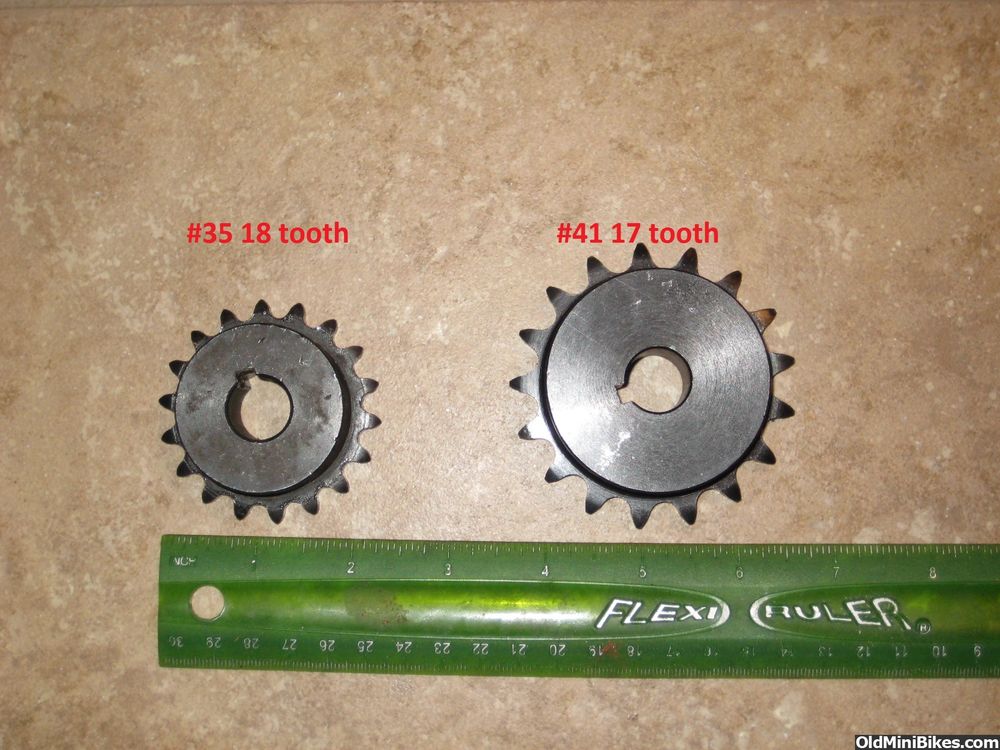On my current project, I am using a standard clutch and a jack shaft. I am running at 5.4:1 and I want to build in more bottom end. Both primary and secondary drives are #35 chain. The clutch is a 12t Max Torque.
Space and clearance issues prevent me changing any sprockets on the jack shaft that would serve my purpose, leaving me only the clutch.
So I figure a ten tooth clutch will do it. Only I cant get a ten tooth clutch with a ten tooth sprocket in #35 chain pitch.
So I ordered a ten tooth clutch in a #41 pitch, and the matching #41 pitch jack shaft sprocket to replace the 18 tooth #35.
Today I got the replacement #41 17 tooth sprocket. It's huge. That was my first clue. An 18t #35 sprocket has a diameter of 2.1 inches, while an 18t #41 sprocket has a diameter of nearly 2.9 inches. That is huge. (You cant get a #41 sprocket in 18t, but that is beside the point)
Further looking into this, that 10t #41 sprocket is significantly larger in diameter than a 12t #35 sprocket, so the clutch I just ordered with only ten teeth is going to be larger in diameter than my #35 with 12t.
All of these years doing this, all of the hundreds of times looking at calculators and spread sheets, it never dawned on me that I wasn't looking at "teeth" at all, but diameters of wheels that might as well have been pulleys, meshed gears, or sail boat winches.
I challenge anyone to show me one of those "on line" calculators that make allowances for other chain sizes, or even one that says it's for a specific chain pitch.
And I am MORE than happy for someone to tell me I am going at this wrong, and too many mind altering substances while listening to Stairway to Heaven destroyed one too many brain cells. :laugh:
Space and clearance issues prevent me changing any sprockets on the jack shaft that would serve my purpose, leaving me only the clutch.
So I figure a ten tooth clutch will do it. Only I cant get a ten tooth clutch with a ten tooth sprocket in #35 chain pitch.
So I ordered a ten tooth clutch in a #41 pitch, and the matching #41 pitch jack shaft sprocket to replace the 18 tooth #35.
Today I got the replacement #41 17 tooth sprocket. It's huge. That was my first clue. An 18t #35 sprocket has a diameter of 2.1 inches, while an 18t #41 sprocket has a diameter of nearly 2.9 inches. That is huge. (You cant get a #41 sprocket in 18t, but that is beside the point)
Further looking into this, that 10t #41 sprocket is significantly larger in diameter than a 12t #35 sprocket, so the clutch I just ordered with only ten teeth is going to be larger in diameter than my #35 with 12t.
All of these years doing this, all of the hundreds of times looking at calculators and spread sheets, it never dawned on me that I wasn't looking at "teeth" at all, but diameters of wheels that might as well have been pulleys, meshed gears, or sail boat winches.
I challenge anyone to show me one of those "on line" calculators that make allowances for other chain sizes, or even one that says it's for a specific chain pitch.
And I am MORE than happy for someone to tell me I am going at this wrong, and too many mind altering substances while listening to Stairway to Heaven destroyed one too many brain cells. :laugh:



 I would essentially be starting over from scratch. I'll end my commentary here-in, and post what I decide back in the build thread. It's a pretty interesting challenge, and despite the fact that it "sucks," I find the fact that this snuck up on me fascinating.
I would essentially be starting over from scratch. I'll end my commentary here-in, and post what I decide back in the build thread. It's a pretty interesting challenge, and despite the fact that it "sucks," I find the fact that this snuck up on me fascinating.